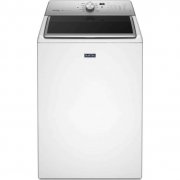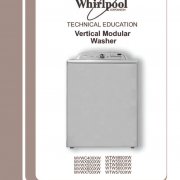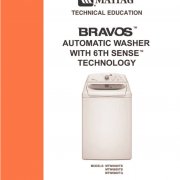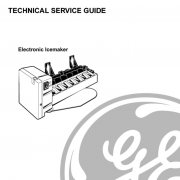New Gas Dryers
You may be surprised to discover that gas dryers don’t differ much mechanically from one dryer brand to another! The burner components used in a Frigidaire, Maytag, LG, Samsung, or Whirlpool gas dryer are almost exactly the same except for a few minor placement and orientation differences. However, there
are a few significant differences in dryer cabinet assembly, air flow, and drum suspension mechanics. Gas dryers are a small minority compared to electric dryers sold nationally. Even though gas dryers are usually about a hundred dollars more than their electric dryer counter parts they are more cost effective to use and therefore generally cost less over the dryer’s life span. Most gas dryers arrive from the manufacturer set for natural gas. However, most can be converted to use propane or butane gases if needed. The most common problem with gas dryers are valve solenoids and ducting clogs that lead to thermal fuse failure or hi-limit thermostat problems.
New Electric Dryers
Electric dryers account for about 80% of dryers sold in the USA. The mechanics of electric dryers are slightly less complex than that of a gas dryer, so it is usually easier to troubleshoot and repair common problems that may emerge. Common points of failure for the electric dryer are the heating element, thermal fuse problems, and basic mechanical issues like broken dryer belts, drum rollers, and bearings. There can be large differences in the cost of common replacement parts for example some dryer heating elements may only run 40.00 while others may cost 150.00 so it’s wise to research the cost of dryer replacement parts prior to buying your new dryer. Or better yet ask your sales person how much it would cost to replace the dryer’s heating element out of warranty.
Dryer Styles (Pros and Cons)
Dryer Serviceability
Some dryer styles are much easier to clean, service, and repair than others! If you are a do-it-yourself kind of person this should be a buying consideration. Whirlpool top lint trap dryers are extremely easy to open and repair, while LG, Samsung, and other high end Whirlpool, Maytag, and Frigidaire dryers may require a major time commitment to service or repair. Another consideration is the newest fan dangled technology… Hopefully your dryer is going to last for more than ten years, while the latest tech is outdated in about two. So think a few years down the road before you buy a dryer that can have chat with the washer, or order a latte from down the street.
Dryer Lint Trap Location
When you are shopping for a new dryer you may not think much about the lint trap or where it is located, but this is a major clue to what is inside that shinny dryer shell. By far the majority of dryers will have the lint trap conveniently situated at the front of the dryer for easy access and cleaning. However, the lint filtering effectiveness of this style is significantly lower than that of a top lint trap dryer model. If you do end up buying a front lint trap dryer just remember that keeping that screen clean is that much more important. It is also helpful to stop the dryer mid cycle and clean the trap if you are drying something that you know will shed a lot of lint like a new set of towels.
Dryer Drum Styles
This my be a little difficult to detect but there are two main styles of clothes dryer drum engineering. Some dryers have a metallic looking back wall with a bunch of vent holes while others have a more solid looking back wall with a single air entry port. The first dryer drum style offers slightly more even heating but tend to be more difficult to service and repair. They also create an area for lint to build up reducing air flow. While the second style uses heavier drum support rollers that hold up slightly better and leave less areas for lint to collect.
Questions You Should Ask In Your Search For The Best Dryer:
Who will service my dryer if I have a problem?
How long will it take to have a service person help me if I have a dryer problem?
Are extended warranties available for my dryer? (Extended dryer warranties are fine, but don’t pay too much! Dryer problems are rare in the first five years.)
When my dryer is out of the warranty period, how much will your company charge to complete a common repair like replacing the ignitor, or heating element?
Are repair parts for this dryer available if I need them?
Are repair parts for this dryer more or less expensive than other dryer brand options?
How long has this dryer style been in production? (New designs are often the source of new problems. Also dryers are often released for sale before repair parts are available!)
New Dryer Features (What the heck is that for?)
Clothes Dryer Capacity
Don’t get hung out to dry on dryer capacity! Dryer capacity is not a huge issue. Most dryer capacities are described as extra large capacity, super capacity, or even super plus capacity, I guess “small” is not a sales friendly term. Any normal capacity dryer will be able to handle everything you can serve it from the largest capacity washer on the market. The only difference a large dryer capacity makes is a slight improvement in dying times. Because fabric releases the most moisture during it’s fall time in the dryer drum… bigger dryer drum = more fall time = faster drying, realistically the difference is almost to small to measure.
To Steam or Not to Steam…
Steam is the new buzz word in dryers and appliances in general. In fact LG and Whirlpool have even grappled in court over steam dryer advertising terms. The sales pitch is this… Steam can be used in dryers to soften fabrics and reduce wrinkling and also because steam can reach much higher temperatures and have a sanitizing effect. (If Generated in a boiler) When it comes to dryers lets think about this for a moment… Water evaporating = steam… So what dryer is not a steam dryer? Honestly it seems like a waist of money to me but if you want the newest and best go for it. If you have a steam dryer and have noticed a real difference beyond perceived benefits please let me know in the comments.
Electronic vs. Mechanical Dryer Controls
Electronic dryer controls are necessary for the use of high end moisture and temperature sensors. These controls also commonly have built in self diagnostic modes that can be helpful for dryer troubleshooting and repair. However, dryer control boards tend to be very expensive to replace should they fail. Mechanical dryer cycle timers are also costly to replace but are slightly less likely to fail and in some cases can be opened and repaired. While there are some efficiency and fabric care benefits to highly accurate moisture and temperature sensitivity, I generally advise people to stick with the mechanical style of dryer timer if possible.
Automatic vs. Electronic Moisture Sensors
Dryer moisture sensing options have real benefits and significant functional differences. Most dryers have a “more dry” “less dry” option but there are two main ways that dryers sense moisture levels and use this information, “automatic dry” and “electronic dry”. An automatic dryer sensor uses the normal cycling of the dryer’s heat source to advance the dryer’s cycle time. When the dryer is actively heating the drum the timer advances and when the heat source is cycled off to cool down thecycle time stalls. Because the presence of moisture in the dryer will slow the dryer’s cycling process this effect is used to approximately control the proper cycle time for fabrics in the dryer to reach a desired dryness level. As you might imagine the accuracy and results are average. The other method is “electronic dry” which is sold under a few different names. Electronic dry uses two long strips of metal located somewhere inside the dryer drum to detect moisture in the fabric being dried. Heres how it works… Depending on your desired moisture setting the control has a number in it’s little computer brain, and the control will try to count down from that number to zero, for example “more dry” might be 80 while “less dry” is 30. Water is a pretty good conductor of electricity, so whenever clothing containing moisture bridges the gap between the dryer’s two sensing strips the count down is reset. (very low voltages) If the clothing contains little or no moisture then it can bridge the gap of the strips as it passes but the counter is not reset. When zero is reached the cycle ends. This is a very accurate form of automatic cycle adjustment and is usually well worth the money in fabric care and drying efficiency.
Finish Guard
The finish guard dryer feature has been marketed under many different names, like “extended tumble” and “press saver”. Basically if your like me you don’t run to the dryer the moment the cycle is finished so wrinkles tend to set into the clothing. This feature will tumble the fabric in the dryer every few minutes after the cycle is over to move them around in the dryer drum and save you some ironing time. I highly recommend this feature! It comes standard on most all dryers but if the one your looking at does not have something like this you should strongly consider this inexpensive dryer option.




